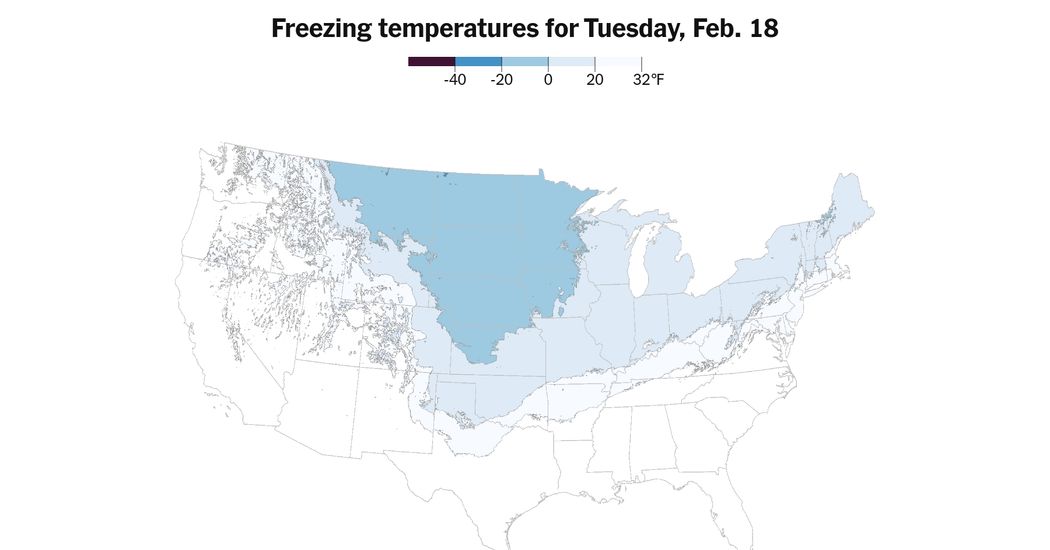A powerful surge of arctic air from Canada descended on the Central and Eastern United States this week, delivering record-breaking cold and life-threatening low wind chills even to regions accustomed to frigid temperatures.
The disruptive winter storm is forecast to bring snow and ice from the Central Plains to the East Coast.
In Milwaukee’s East Side on Tuesday, voters were supposed to be braving the cold to choose a new alderman, but next to the Firehouse Station 6 polling site, a water main broke after frost penetrated it, blocking off access. Water filled the street and sidewalks six inches deep in some spots. Tires froze to the streets.
“People in Wisconsin are generally pretty hardy,” said Emma Nelson, a chief election inspector. “But there’s a lot of people that, if they were already on the fence about coming down, this weather may be prohibitive for them.”
The National Weather Service warned that this “widespread extreme cold threat” would send temperatures plunging 30 degrees below average near the Canadian border for the next couple of mornings. Numerous daily temperature records were likely to be broken, with below-zero high temperatures from Montana and the Dakotas to the upper Midwest and sections of the Central Plains. Freezing conditions may reach even the Gulf Coast by Thursday morning.
Extreme cold warnings and cold-weather advisories were issued for areas across the northern Plains and upper Midwest down to central Texas, potentially affecting millions of people.
The Weather Prediction Center warned of dangerous wind chill temperatures capable of causing frostbite within minutes. In the Northern Plains, wind chills between minus 30 and minus 60 degrees Fahrenheit could persist for several days.
Jeremy Reha was outside Food Bank of Iowa’s warehouse on Des Moines’ East Side before dawn Tuesday morning, starting up refrigeration units on trucks in minus 12 degree weather. The same diesel engines that keep donated grapefruits, apples, and eggs cool in summer work as heaters inside the truck boxes on days like today, he said, when drivers haul food to meal sites and pantries throughout Central Iowa.
Dressed in layers topped off with a Chicago Bears cap (“I’ve had a rough last 30 years or so,” he joked), Mr. Reha said he left some trucks running all night to keep their diesel fuel from turning to gelatin.
“If our trucks aren’t running, we can’t feed people,” Mr. Reha said, adding that Tuesday was among the coldest days he had seen in his 12 years with the nonprofit.
The office of the Weather Service in Bismarck, N.D., described the conditions as “life threatening,” cautioning that wind chills in western and central North Dakota could lead to hypothermia.
Subzero wind chills are also expected to extend as far south as Texas, Arkansas and western Tennessee and Kentucky.
Winter storm expected for the nation’s midsection.
In addition to the extreme cold, snow and gusty winds are expected Tuesday across the Central Plains, including parts of Kansas, Oklahoma, Arkansas and Missouri. The Weather Prediction Center said up to a foot of snow could fall by Wednesday morning.
Much of southern Missouri and northern Arkansas are “looking at snowfall accumulations of eight to 12 inches, and it’s possible a couple of places might just get slightly higher,” said Andrew Orrison, a meteorologist from the National Weather Service.
A swath of freezing rain and sleet could also spread farther south across Oklahoma to Arkansas later Tuesday and into the night.
As the storm moves east, heavy snow was expected over southeastern Virginia and northeastern North Carolina on Wednesday.
Areas from eastern Kentucky to southern West Virginia were forecast to get four to six inches of snow — possibly more in some areas. Southeastern Virginia and northeastern North Carolina could see up to eight inches. Snow was expected in parts of Tennessee and Kentucky that were hit by deadly flooding over the weekend.
Governor Patrick Morrisey of West Virginia confirmed on Tuesday that a second person had died in his state’s floods. Both deaths happened in McDowell County, W.V.
Significant icing from freezing rain was also expected over southeastern North Carolina, with a wintry mix moving into the interior Deep South early Wednesday.
The storm is forecast to track off the East Coast Wednesday night into Thursday morning. “Current models suggest that most of the winter weather will stay south of New England,” said Ashton Robinson Cook, a meteorologist with the Weather Service. Forecasters in New York said the storm would pass far enough south and east to spare the area any significant snowfall.
Temperatures will slowly moderate over the weekend, though Mr. Robinson Cook noted that “they will still be below average, but not as bitterly cold.”
In the Upper Midwest, many residents — including the animals — shrugged off the cold. After odd warming events and extreme weather driven by climate change, a cold snap felt like a return to normalcy.
Milwaukee Water Works was dealing with numerous water main breaks across the city, in already this month, municipal workers had dealt with 50 similar cases, 130 water main breaks this winter in all.
Horses at the Animal Rescue League of Iowa’s Second Chance Ranch near Des Moines kicked up their heels in their outdoor pens on Tuesday and nipped playfully at one another when a supervisor, Chloe Catron, and a care technician, Brooklyn Wright, drove up shortly after dawn for their morning feeding, which included extra hay and a little alfalfa for added calories.
The horses prefer to be outside even on nights like last night, when the mercury dipped to minus 12, Ms. Catron said.
By midmorning, the horses, most rescued from neglect and hoarding situations, stood in the sunshine munching hay and grain. The humans had the tougher job, going outdoors to conduct health checks and make sure water heaters were working.
“You warm up,” Ms. Catron said, “and then go back and do what you’ve got to do.”
Judson Jones, Addison Lathers in Milwaukee and Ann Hinga Klein in Des Moines contributed reporting.





